clock CHEVROLET CAMARO 1967 1.G Chassis Owner's Guide
[x] Cancel search | Manufacturer: CHEVROLET, Model Year: 1967, Model line: CAMARO, Model: CHEVROLET CAMARO 1967 1.GPages: 659, PDF Size: 114.24 MB
Page 442 of 659

STEERING 9-2
Fig.
1—Cover
Attaching Bolts—Chevy li Shown
ADJUSTMENTS
STEERING
GEAR
Before any adjustments are made to the steering gear
in an attempt to correct such conditions as shimmy,
loose or hard steering etc., a careful check should be
made of front end alignment, shock absorbers, wheel
balance and tire pressure for possible cause.
Correct adjustment of the steering gear is very im-
portant. Perform adjustments following the sequence
listed below,
1.
Remove pitman arm nut and mark relation of pitman
arm position to sector shaft. Remove pitman arm
with Tool J- 6632 as shown in Figure 2.
2.
Loosen the pitman shaft lash adjuster screw locknut
and turn the adjuster screw a few turns in a counter-
clockwise direction (fig. 3). This removes the load
Fig. 2—Removing Pitman Arm
imposed on the worm bearings by the close meshing
of rack and sector teeth. Turn steering wheel gently
in one direction until stopped by gear, then back away
about one turn.
CAUTION: Do not turn steering wheel hard
against stops when steering relay rod is discon-
nected as damage to ball guides may result.
3.
All except Corvette and telescopic columns:
a. Disconnect steering column harness at chassis
wiring connector plug.
b.
Remove horn cap or ornament and using an inch
pound torque wrench and socket on steering wheel
nut, measure torque required to keep the wheel
in motion.
LASH ADJUSTER
SCREW
LOCK NUT
WORM BEARING
ADJUSTER
\
WORM
ADJUSTER
Fig.
3—Steering Gear Adjustment Points
CHEVROLET CHASSIS SERVICE MANUAL
Page 443 of 659
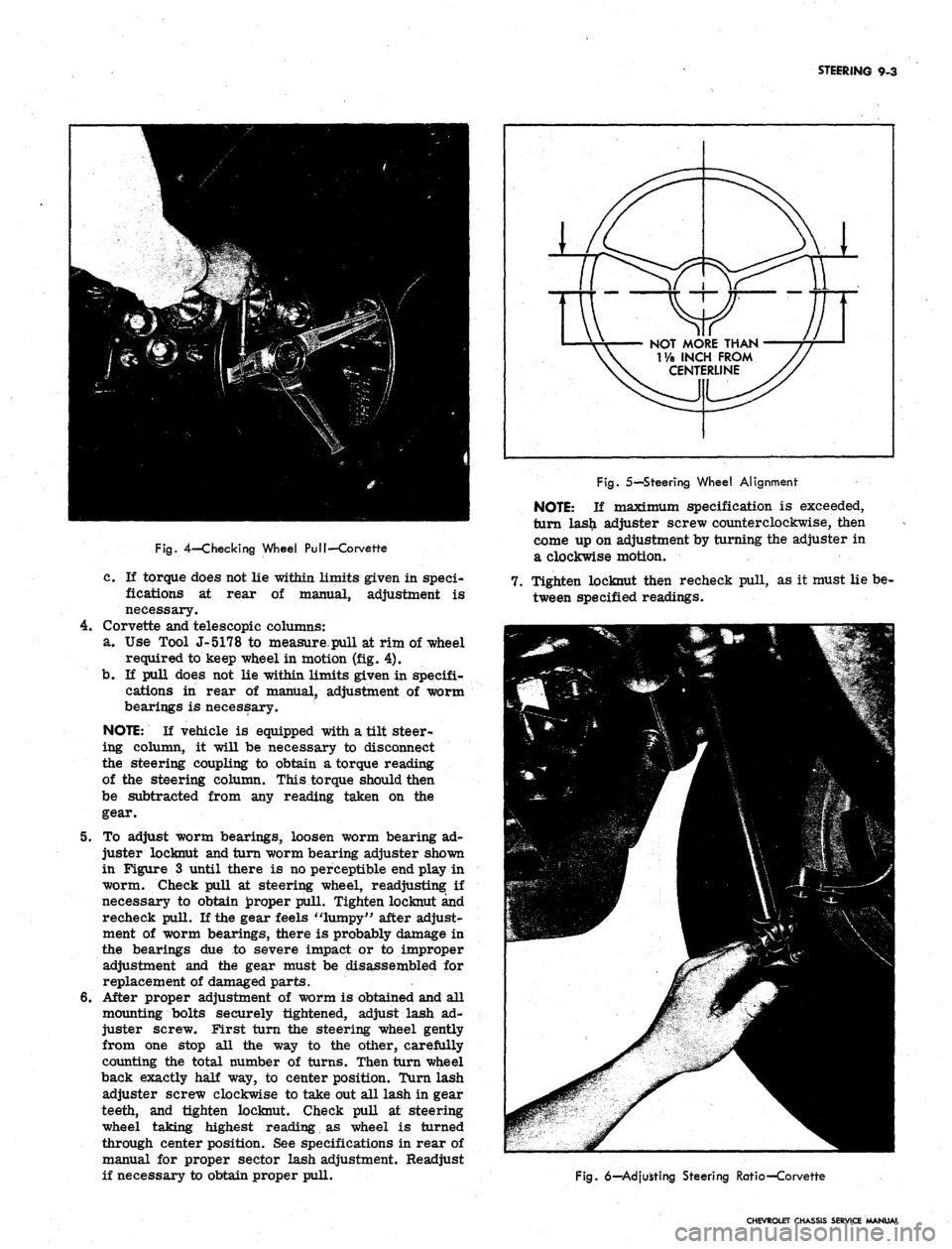
STEERING 9-3
Fig.
4-Checking Wheel PuI!-Corvette
c. If torque does not lie within limits given in speci-
fications at rear of manual, adjustment is
necessary.
4.
Corvette and telescopic columns:
a. Use Tool J-5178 to measure.pull at rim of wheel
required to keep wheel in motion (fig. 4).
b.
If pull does not lie within limits given in specifi-
cations in rear of manual, adjustment of worm
bearings is necessary.
NOTE:
If vehicle is equipped with a tilt steer-
ing column, it will be necessary to disconnect
the steering coupling to obtain a torque reading
of the steering column. This torque should then
be subtracted from any reading taken on the
gear.
5. To adjust worm bearings, loosen worm bearing ad-
juster locknut and turn worm bearing adjuster shown
in Figure 3 until there is no perceptible end play in
worm. Check pull at steering wheel, readjusting: if
necessary to obtain proper pull. Tighten locknut and
recheck pull. If the gear feels "lumpy" after adjust-
ment of worm bearings, there is probably damage in
the bearings due to severe impact or to improper
adjustment and the gear must be disassembled for
replacement of damaged parts.
6. After proper adjustment of worm is obtained and all
mounting bolts securely tightened, adjust lash ad-
juster screw. First turn the steering wheel gently
from one stop all the way to the other, carefully
counting the total number of turns. Then turn wheel
back exactly half way, to center position. Turn lash
adjuster screw clockwise to take out all lash in gear
teeth, and tighten locknut. Check pull at steering
wheel taking highest reading as wheel is turned
through center position. See specifications in rear of
manual for proper sector lash adjustment. Readjust
if necessary to obtain proper pull.
NOT MORE THAN
T/a INCH FROM
CENTERLINE
Fig.
5—Steering Wheel Alignment
NOTE:
If maximum specification is exceeded,
turn las£ adjuster screw counterclockwise, then
come up on adjustment by turning the adjuster in
a clockwise motion.
7. Tighten locknut then recheck pull, as it must lie be-
tween specified readings.
Fig.
6—Adjusting Steering Ratio—Corvette
CHEVROLET CHASSIS SERVICE MANUAL
Page 444 of 659
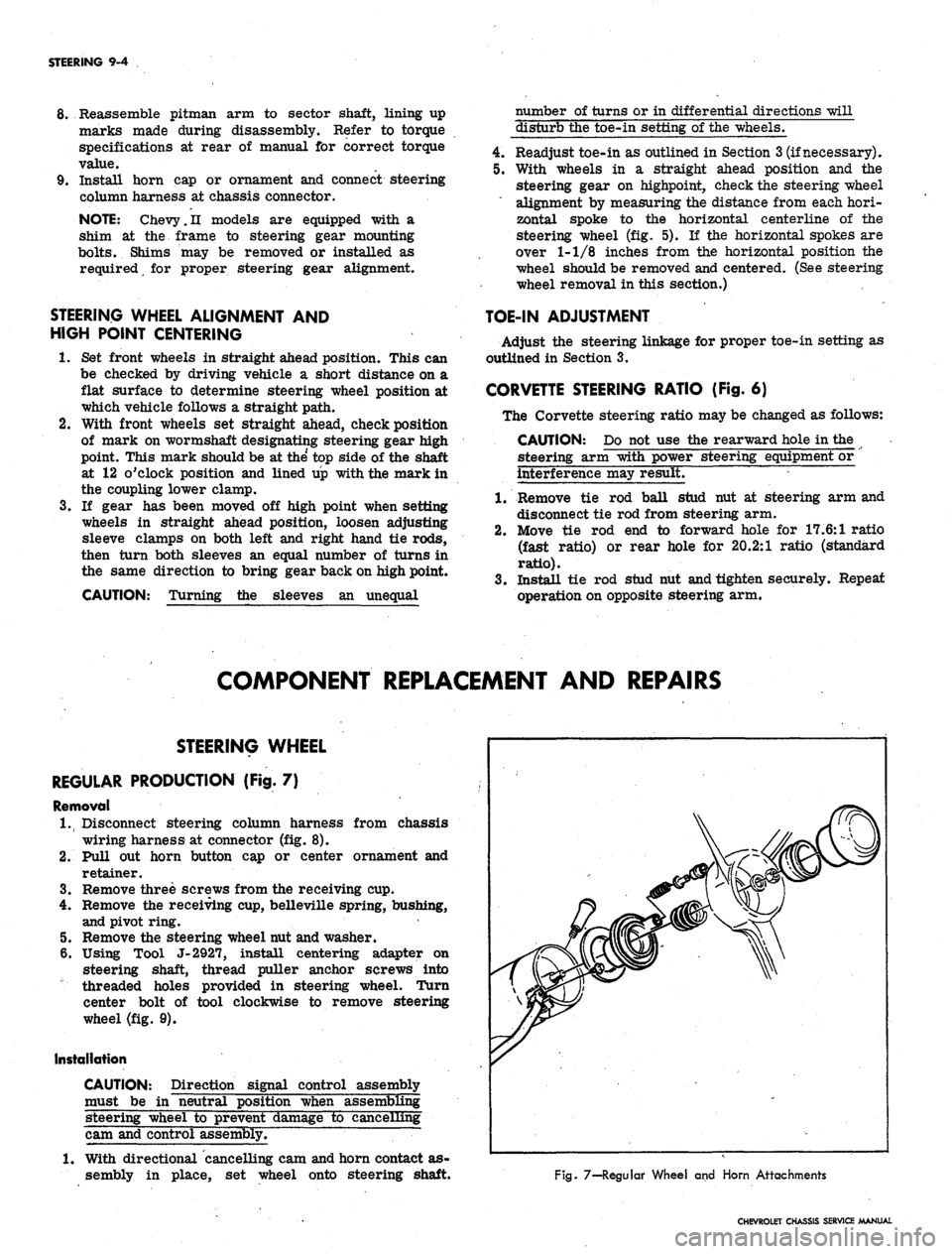
STEERING 9-4
8. Reassemble pitman arm to sector shaft, lining up
marks made during disassembly. Refer to torque
specifications at rear of manual for correct torque
value.
9. Install horn cap or ornament and connect steering
column harness at chassis connector.
NOTE:
Chevy.n models are equipped with a
shim at the frame to steering gear mounting
bolts.
Shims may be removed or installed as
required for proper steering gear alignment.
STEERING WHEEL ALIGNMENT AND
HIGH POINT CENTERING
1.
Set front wheels in straight ahead position. This can
be checked by driving vehicle a short distance on a
flat surface to determine steering wheel position at
which vehicle follows a straight path.
2.
With front wheels set straight ahead, check position
of mark on wormshaft designating steering gear high
point. This mark should be at the top side of the shaft
at 12 o'clock position and lined up with the mark in
the coupling lower clamp.
3.
If gear has been moved off high point when setting
wheels in straight ahead position, loosen adjusting
sleeve clamps on both left and right hand tie rods,
then turn both sleeves an equal number of turns in
the same direction to bring gear back on high point.
CAUTION: Turning the sleeves an unequal
number of turns or in differential directions will
disturb the toe-in setting of the wheels.
4.
Readjust toe-in as outlined in Section 3 (if necessary).
5. With wheels in a straight ahead position and the
steering gear on highpoint, check the steering wheel
alignment by measuring the distance from each hori-
zontal spoke to the horizontal centerline of the
steering wheel (fig. 5). If the horizontal spokes are
over 1-1/8 inches from the horizontal position the
wheel should be removed and centered. (See steering
wheel removal in this section.)
TOE-IN ADJUSTMENT
Adjust the steering linkage for proper toe-in setting as
outlined in Section 3.
CORVETTE STEERING RATIO (Fig. 6)
The Corvette steering ratio may be changed as follows:
CAUTION: Do not use the rearward hole in the
steering arm with power steering equipment or
interference may result.
1.
Remove tie rod ball stud nut at steering arm and
disconnect tie rod from steering arm.
2.
Move tie rod end to forward hole for 17.6:1 ratio
(fast ratio) or rear hole for 20.2:1 ratio (standard
ratio).
3.
Install tie rod stud nut and tighten securely. Repeat
operation on opposite steering arm.
COMPONENT REPLACEMENT AND REPAIRS
STEERING WHEEL
REGULAR PRODUCTION (Fig. 7)
Removal
1.
Disconnect steering column harness from chassis
wiring harness at connector (fig. 8).
2.
Pull out horn button cap or center ornament and
retainer.
3.
Remove three screws from the receiving cup.
4.
Remove the receiving cup, belleville spring, bushing,
and pivot ring.
5. Remove the steering wheel nut and washer.
6. Using Tool J-2927, install centering adapter on
steering shaft, thread puller anchor screws into
threaded holes provided in steering wheel. Turn
center bolt of tool clockwise to remove steering
wheel (fig. 9).
Installation
CAUTION: Direction signal control assembly
must be in "neutral position when assembling
steering wheel to prevent damage to cancelling
cam and control assembly.
1.
With directional cancelling cam and horn contact as-
sembly in place, set wheel onto steering shaft.
Fig. 7—-Regular Wheel and Horn Attachments
CHEVROLET CHASSIS SERVICE MANUAL
Page 445 of 659
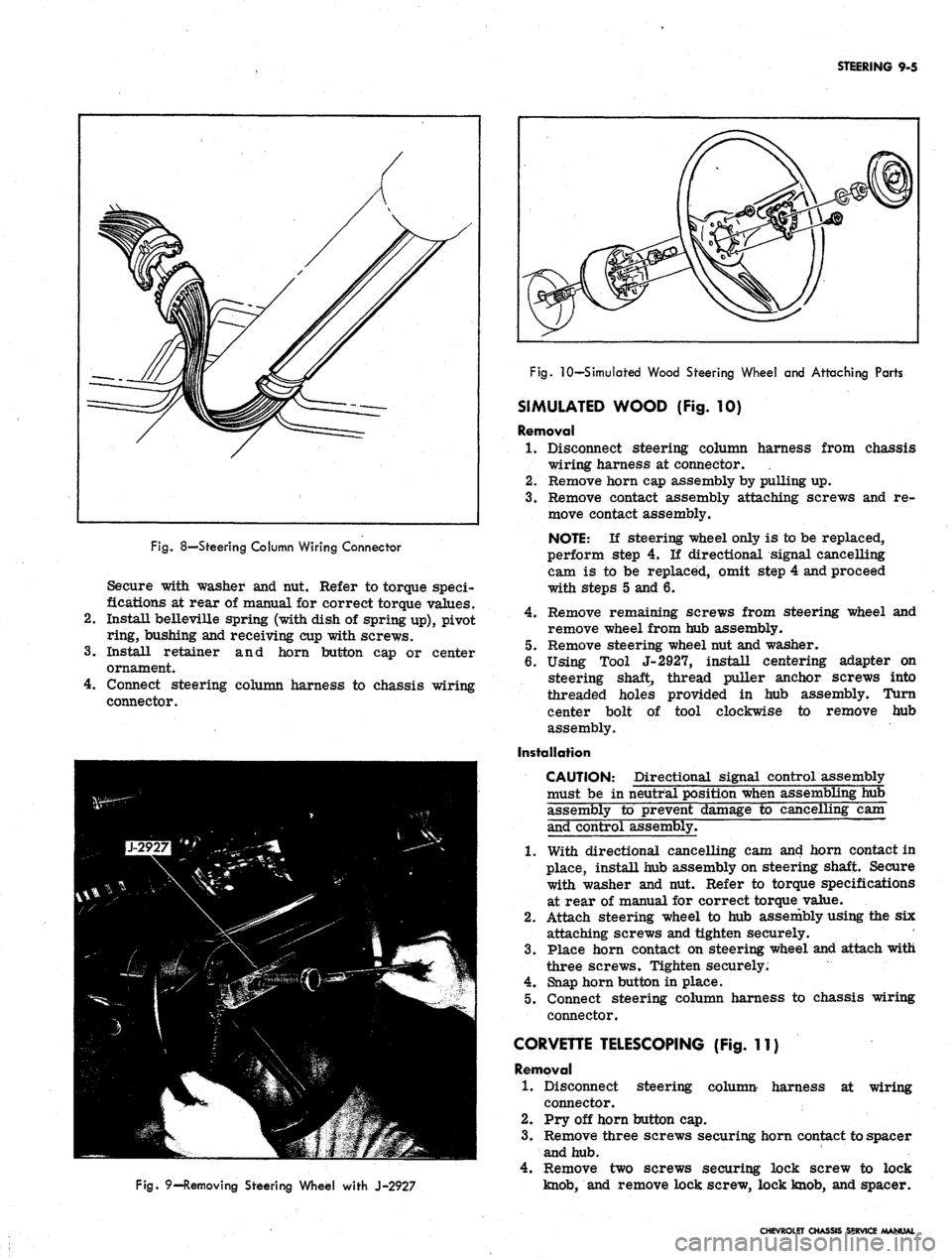
STEERING 9-5
Fig.
8—Steering Column Wiring Connector
Secure with washer and nut. Refer to torque speci-
fications at rear of manual for correct torque values.
Install belleville spring (with dish of spring up), pivot
ring, bushing and receiving cup with screws.
Install retainer and horn button cap or center
ornament.
Connect steering column harness to chassis wiring
connector.
Fig.
9—Removing Steering Wheel with J-2927
Fig.
10—Simulated Wood Steering Wheel and Attaching Parts
SIMULATED WOOD (Fig. 10)
Removal
1.
Disconnect steering column harness from chassis
wiring harness at connector.
2.
Remove horn cap assembly by pulling up.
3.
Remove contact assembly attaching screws and re-
move contact assembly.
NOTE:
If steering wheel only is to be replaced,
perform step 4. If directional signal cancelling
cam is to be replaced, omit step 4 and proceed
with steps 5 and 6.
4.
Remove remaining screws from steering wheel and
remove wheel from hub assembly.
5. Remove steering wheel nut and washer.
6. Using Tool J-2927, install centering adapter on
steering shaft, thread puller anchor screws into
threaded holes provided in hub assembly. Turn
center bolt of tool clockwise to remove hub
assembly.
Installation
CAUTION: Directional signal control assembly
must be in neutral position when assembling hub
assembly to prevent damage to cancelling cam
and control assembly.
1.
With directional cancelling cam and horn contact in
place, install hub assembly on steering shaft. Secure
with washer and nut. Refer to torque specifications
at rear of manual for correct torque value.
2.
Attach steering wheel to hub assembly using the six
attaching screws and tighten securely.
3.
Place horn contact on steering wheel and attach with
three screws. Tighten securely.
4.
Snap horn button in place.
5. Connect steering column harness to chassis wiring
connector.
CORVETTE TELESCOPING (Fig. 11)
Removal
1.
Disconnect steering column harness at wiring
connector.
2.
Pry off horn button cap.
3.
Remove three screws securing horn contact to spacer
and hub.
4.
Remove two screws securing lock screw to lock
knob,
and remove lock screw, lock knob, and spacer.
CHEVROLET CHASSIS SERVICE MANUAL
Page 448 of 659
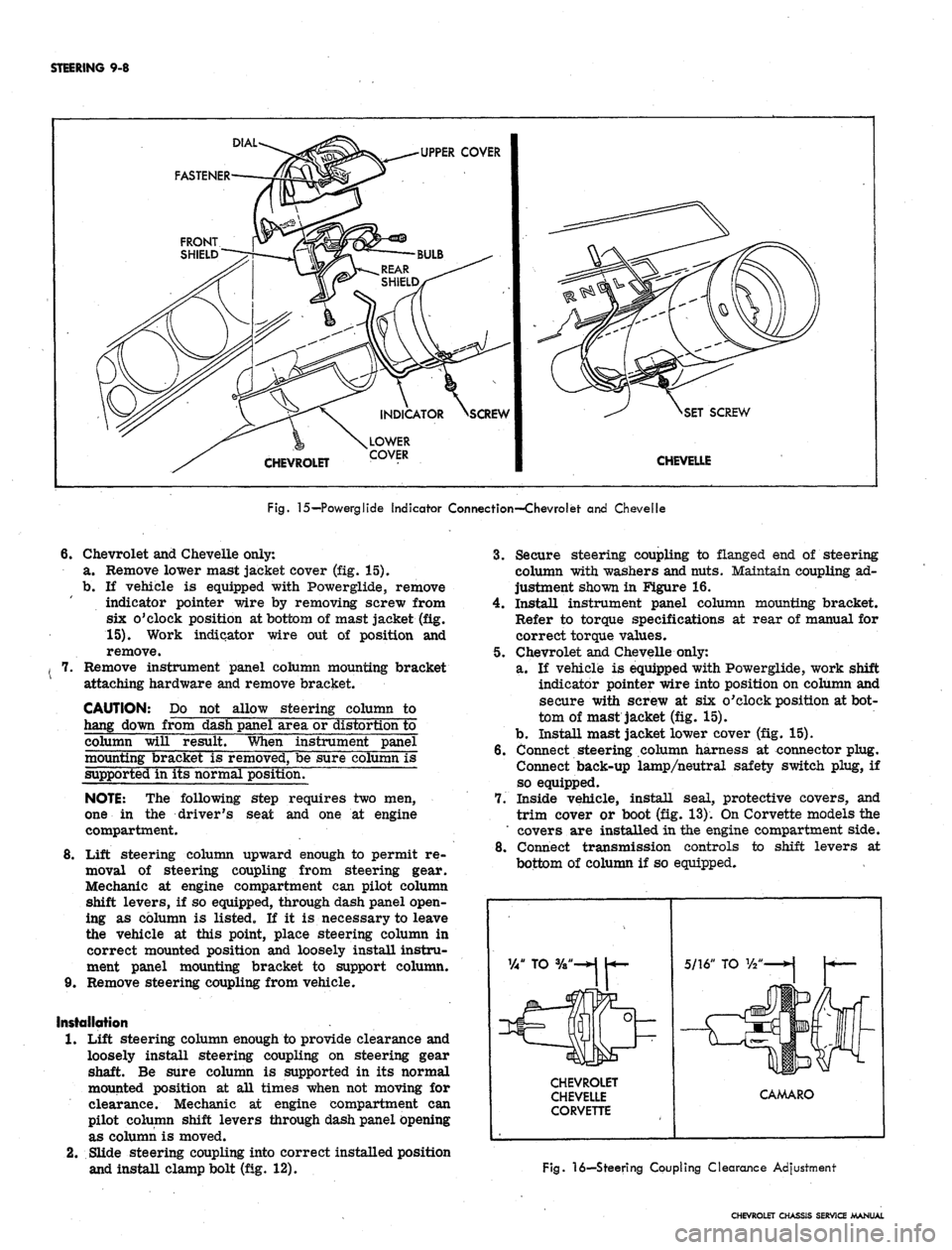
STEERING 9-8
DIAL
UPPER COVER
FASTENER
CHEVROLET
SCREW
CHEVELLE
Fig.
15—Powerglide Indicator Connection—Chevrolet and Chevelle
6.
Chevrolet and Chevelle only:
a. Remove lower mast jacket cover (fig. 15).
b.
If vehicle is equipped with Powerglide, remove
indicator pointer wire by removing screw from
six o'clock position at bottom of mast jacket (fig.
15).
Work indicator wire out of position and
remove.
Remove instrument panel column mounting bracket
attaching hardware and remove bracket.
CAUTION: Do not allow steering column to
hang down from dash panel area or distortion to
column will result. When instrument panel
mounting bracket is removed, be sure column is
supported in its normal position.
NOTE:
The following step requires two men,
one in the driver's seat and one at engine
compartment.
8
Lift steering column upward enough to permit re-
moval of steering coupling from steering gear.
Mechanic at engine compartment can pilot column
shift levers, if so equipped, through dash panel open-
ing as column is listed. If it is necessary to leave
the vehicle at this point, place steering column in
correct mounted position and loosely install instru-
ment panel mounting bracket to support column.
9. Remove steering coupling from vehicle.
Installation
1.
Lift steering column enough to provide clearance and
loosely install steering coupling on steering gear
shaft. Be sure column is supported in its normal
mounted position at all times when not moving for
clearance. Mechanic at engine compartment can
pilot column shift levers through dash panel opening
as column is moved.
2.
Slide steering coupling into correct installed position
and install clamp bolt (fig. 12).
3.
Secure steering coupling to flanged end of steering
column with washers and nuts. Maintain coupling ad-
justment shown in Figure 16.
4.
Install instrument panel column mounting bracket.
Refer to torque specifications at rear of manual for
correct torque values.
5. Chevrolet and Chevelle only:
a. If vehicle is equipped with Powerglide, work shift
indicator pointer wire into position on column and
secure with screw at six o'clock position at bot-
tom of mast jacket (fig. 15).
b.
Install mast jacket lower cover (fig. 15).
6. Connect steering column harness at connector plug.
Connect back-up lamp/neutral safety switch plug, if
so equipped.
7. Inside vehicle, install seal, protective covers, and
trim cover or boot (fig. 13). On Corvette models the
' covers are installed in the engine compartment side.
8. Connect transmission controls to shift levers at
bottom of column if so equipped.
CHEVROLET
CHEVELLE
CORVETTE
CAMARO
Fig.
16—Steering Coupling Clearance Adjustment
CHEVROLET CHASSIS SERVICE MANUAL
Page 450 of 659

STEERING 9-10
SECTOR SHAFT SEAL REPLACEMENT
A faulty seal may be replaced without removal of
steering gear from car by removing pitman arm as out-
lined under Maintenance and Adjustments--Steering Gear
Adjustments and proceed as follows:
1.
Loose lash adjuster lock nut and turn lash adjuster
screw several turns counterclockwise.
2.
Remove three cap screws holding side cover to gear
bushing.
3.
Pull side cover and sector shaft from gear housing
as a unit. Do not separate side cover from sector
shaft.
4.
Pull sector shaft seal from gear housing using
hooked tool or pliers.
5. Coat new seal with chassis grease and position in
sector shaft bore.
6. Place a socket or piece of pipe of suitable diameter
on top of seal and drive seal into bore by tapping
pipe or socket with soft hammer.
7. Install sector shaft side cover assembly, being care-
ful not to damage new seal with splines on end of
shaft; splines may be wrapped with a few turns of
tape to prevent this.
8. Install new side cover gasket and align side cover on
gear housing and install cap screw.
9. Perform steering gear adjustment and install pitman
arm as outlined under Maintenance and Adjustments.
STEERING COLUMN
All models are equipped with new energy absorbing
steering columns. The columns are of five basic designs
as follows:
1.
Syncromesh. The syncromesh column is used on
models with standard, column mounted, conventional
shift levers. The shift tube, within the outer mast
jacket, includes two lower shift levers for connection
to the transmission control linkage.
2.
Automatic and floor shift. This column is used on
models equipped with column mounted powerglide
shift levers, or models with floor shift. If the ve-
hicle has the column mounted powerglide shift con-
trol, the inner shift tube has a single lower shift
lever for connection to the transmission control
linkage. On floor shift models, no lower shift levers
are present on the shift tube.
3.
Tilt wheel option. The upper end and steering shaft
of this column is specially designed to accommodate
the optional tilt steering wheel.
4.
Standard Corvette Column. The standard Corvette
column is similar in design to the Automatic and
Floor Shift column used on other models, except
no shift tube is used. Other differences are pointed
out in the disassembly and assembly procedures for
Standard Corvette column.
5. Telescopic wheel option. The upper end and steering
shaft of this column is specially designed to ac-
commodate the optional telescoping steering wheel.
To perform service procedures on steering column
upper end components, it is not necessary to remove the
column from the vehicle. The steering wheel, horn com-
ponents, turn signal switch, upper housing with bearing,
shift control lever, hazard warning knob, and upper shift
bowl may all be removed with the column remaining in
the vehicle. When servicing the above components, omit
the removal procedure and proceed with the applicable
disassembly procedures. Because of the numerous dif-
ferences in steering column types, be sure to refer to the
set of instructions below which apply to the exact column
to be serviced:
CAUTION: The outer mast jacket, shift tube, _
steering shaft, and instrument panel column
mounting b
racket
are designed as energy ab-
sorbing units. Because of the design of these
components, it is absolutely necessary to handle
the column with care when performing any serv-
ice operation required. Avoid hammering, jar-
ring, dropping, or leaning on any portion of the
column.
Removal
1.
Disconnect steering column harness at connector.
Disconnect neutral safety switch and back-up lamp
switch connectors if so equipped.
Remove steering wheel as outlined in this section.
Remove nuts and washers securing flanged end of
column to steering gear. On Chevy H models, re-
move nut and clamp bolt securing lower end of steer-
ing column to steering gear.
Disconnect transmission control linkage, if so
equipped, from lower column shift tube, levers.
Chevrolet and Chevy II only: Remove screws at-
taching upper and lower mast jacket covers together.
On Chevrolet, remove screws attaching lower cover
to instrument panel (figs. 15 and 18). Remove lower
cover.
Chevelle only: Remove screws securing mast jacket
trim cover to instrument panel and remove cover
(fig. 15).
Corvette, only: Remove screws securing escutcheon
to instrument panel. Remove screws securing upper
and lower covers together and remove covers.
On Chevrolet and Chevelle columns with Powerglide
shift levers, loosen set screw at six o'clock position
at bottom of column and remove the transmission
shift indicator pointer (fig. 15).
9. Chevrolet only (fig. 19):
a. Remove screws securing cover trim to dash
panel and remove cover trim.
2.
3.
4.
5.
6.
7.
8.
Fig.
18—Mast Jacket Cover Attachments—Chevy II
CHEVROLET CHASSIS SERVICE MANUAL
Page 453 of 659
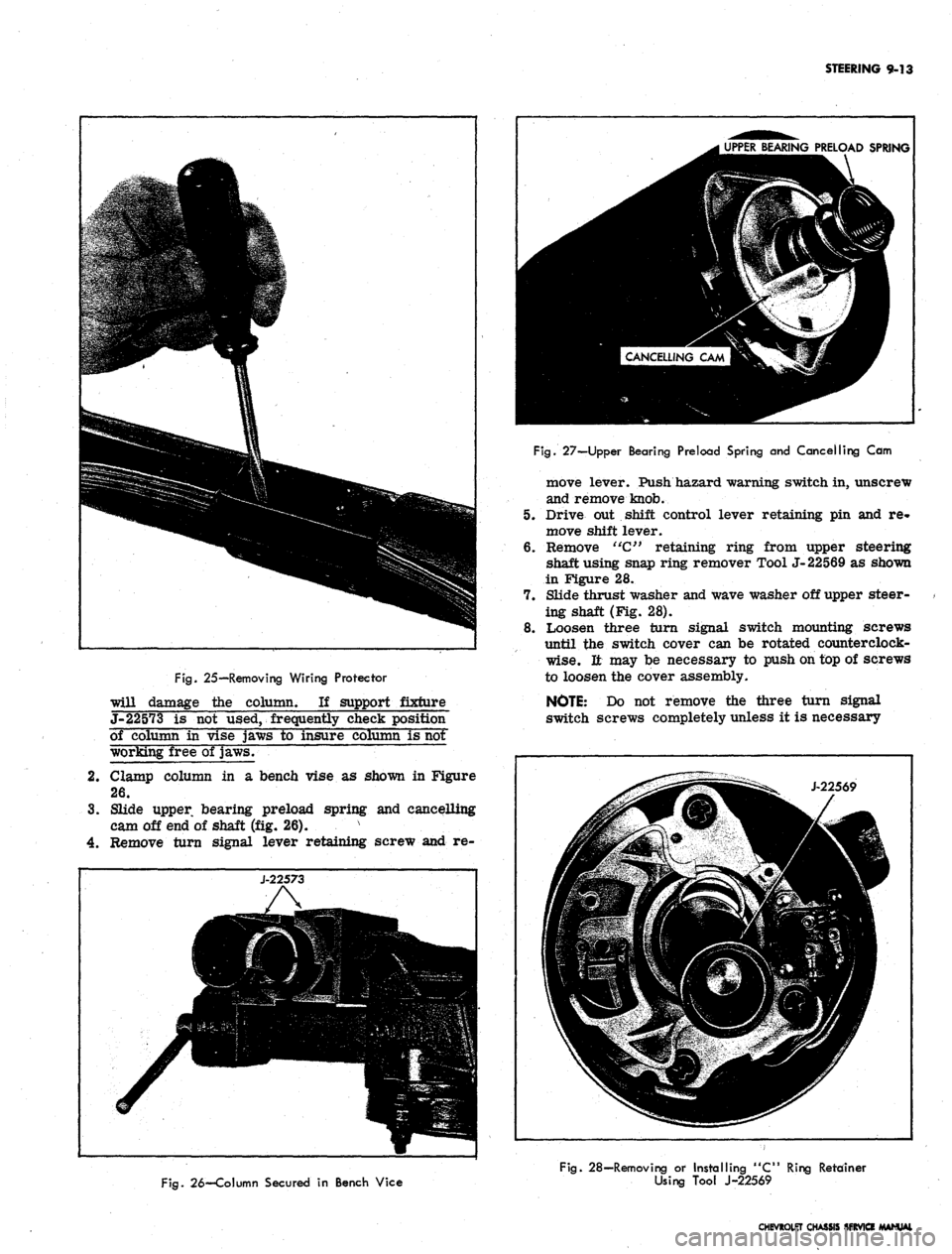
STEERING
9-13
Fig.
25—Removing
Wiring
Protector
will damage the column. If support fixture
J- 22573 is not used, frequently check position
of column in vise jaws to insure column is not
working free of jaws.
2.
Clamp column in a bench vise as shown in Figure
26.
3.
Slide upper bearing preload spring and cancelling
cam off end of shaft (fig. 26).
4.
Remove turn signal lever retaining screw and re-
J
/
P TT-T. ,,.. "~~ ••• -£;:«s-tu
4
• h ^•--
:z:--:vmM
UPPER
BEARING
PRELOAD
SPRING
Fig.
27—Upper
Bearing
Preload
Spring
and
Cancelling
Cam
move lever. Push hazard warning switch in, unscrew
and remove knob.
5. Drive out shift control lever retaining pin and re-
move shift lever.
6. Remove "C" retaining ring from upper steering
shaft using snap ring remover Tool J-22569 as shown
in Figure 28.
7. Slide thrust washer and wave washer off upper steer-
ing shaft (Fig. 28).
8. Loosen three turn signal switch mounting screws
until the switch cover can be rotated counterclock-
wise. It may be necessary to push on top of screws
to loosen the cover assembly.
NOTE:
Do not remove the three turn signal
switch screws completely unless it is necessary
Fig.
26—Column
Secured
in
Bench Vice
Fig.
28—Removing
or
Installing
"C"
Ring
Retainer
Using Tool
J-22569
CHEVROLET CHASSIS 3ERV1CI MANUAL
Page 454 of 659
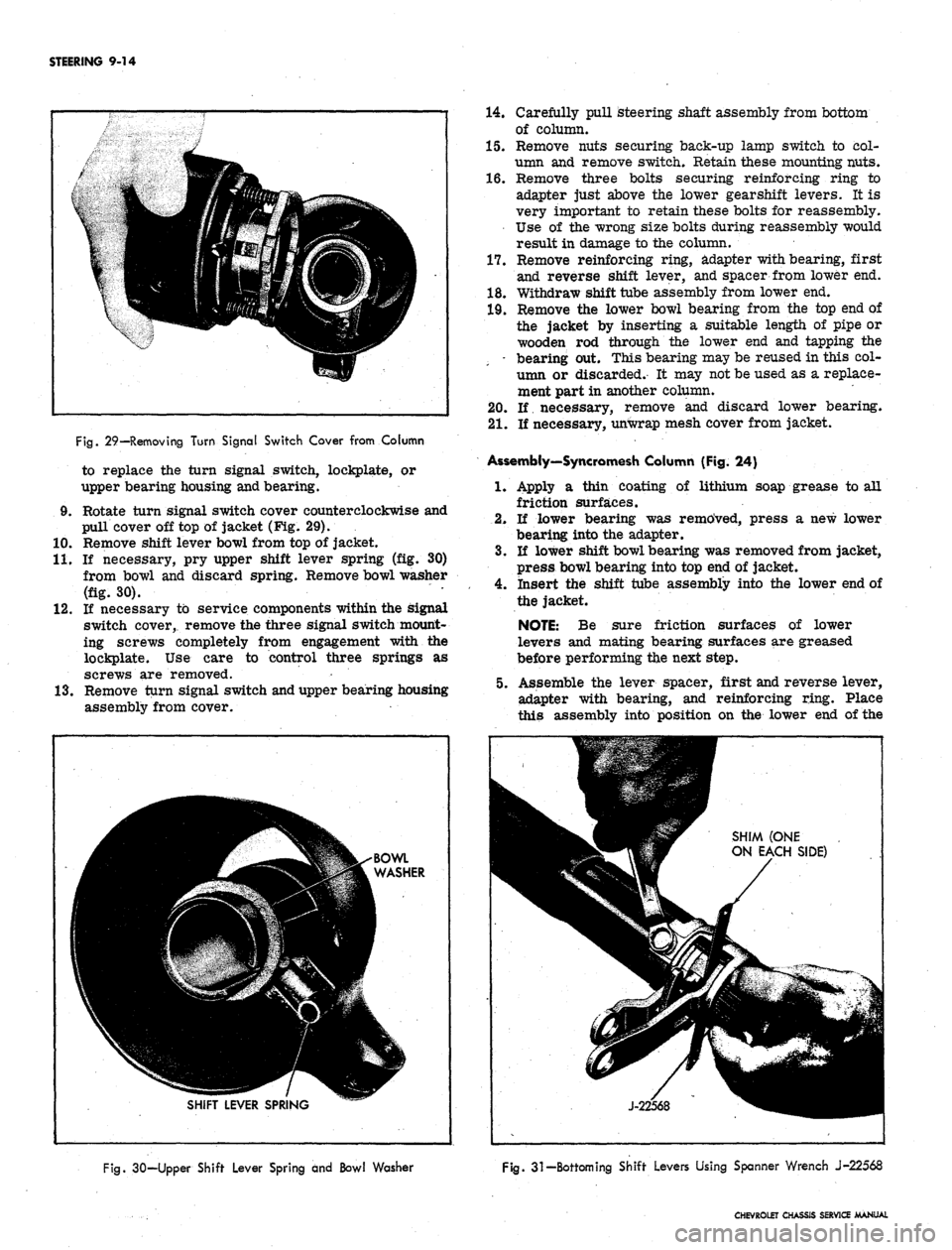
STEERING 9-14
Fig.
29—Removing Turn Signal Switch Cover from Column
to replace the turn signal switch, lockplate, or
upper bearing housing and bearing.
9. Rotate turn signal switch cover counterclockwise and
pull cover off top of jacket (Fig. 29).
10.
Remove shift lever bowl from top of jacket.
11.
If necessary, pry upper shift lever spring (fig. 30)
from bowl and discard spring. Remove bowl washer
(fig. 30).
12.
If necessary to service components within the signal
switch cover, remove the three signal switch mount-
ing screws completely from engagement with the
lockplate. Use care to control three springs as
screws are removed. -
13.
Remove turn signal switch and upper bearing housing
assembly from cover.
H
SHIFT
r
i
LEVER
a
SPRING
I^-BOWL
Sk WASHER
14.
Carefully pull steering shaft assembly from bottom
of column.
15.
Remove nuts securing back-up lamp switch to col-
umn and remove switch. Retain these mounting nuts.
16.
Remove three bolts securing reinforcing ring to
adapter just above the lower gearshift levers. It is
very important to retain these bolts for reassembly.
Use of the wrong size bolts during reassembly would
result in damage to the column.
17.
Remove reinforcing ring, adapter with bearing, first
and reverse shift lever, and spacer from lower end.
18.
Withdraw shift tube assembly from lower end.
19.
Remove the lower bowl bearing from the top end of
the jacket by inserting a suitable length of pipe or
wooden rod through the lower end and tapping the
- bearing out. This bearing may be reused in this col-
umn or discarded. It may not be used as a replace-
ment part in another column.
20.
If necessary, remove and discard lower bearing.
21.
If necessary, unwrap mesh cover from jacket.
Assembly—Syncromesh Column (Fig. 24)
1.
Apply a thin coating of lithium soap grease to all
friction surfaces.
2.
If lower bearing was removed, press a new lower
bearing into the adapter.
3.
If lower shift bowl bearing was removed from jacket,
press bowl bearing into top end of jacket.
4.
Insert the shift tube assembly into the lower end of
the jacket.
NOTE: Be sure friction surfaces of lower
levers and mating bearing surfaces are greased
before performing the next step.
5.
Assemble the lever spacer, first and reverse lever,
adapter with bearing, and reinforcing ring. Place
this assembly into position on the lower end of the
SHIM (ONE
ON EACH SIDE)
Fig.
30—Upper Shift Lever Spring and Bowl Washer
Fig.
31—Bottoming Shift Levers Using Spanner Wrench J-22568
CHEVROLET CHASSIS SERVICE MANUAL
Page 455 of 659
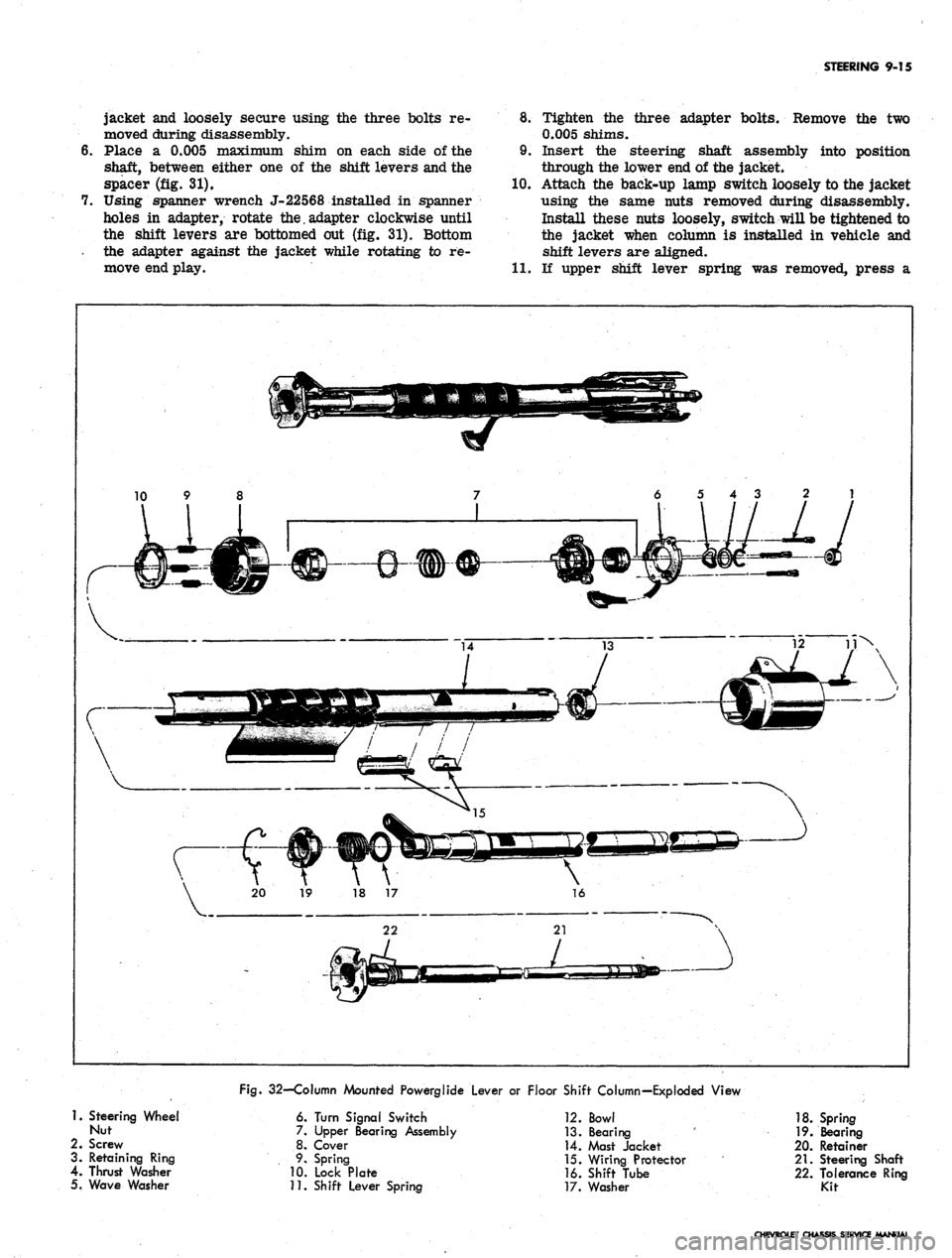
STEERING 9-15
jacket and loosely secure using the three bolts re- 8.
moved during disassembly.
Place a 0.005 maximum shim on each side of the 9.
shaft, between either one of the shift levers and the
spacer (fig. 31). 10.
Using spanner wrench J-22568 installed in spanner
holes in adapter, rotate the.adapter clockwise until
the shift levers are bottomed out (fig. 31). Bottom
the adapter against the jacket while rotating to re-
move end play. 11.
Tighten the three adapter bolts. Remove the two
0.005 shims.
Insert the steering shaft assembly into position
through the lower end of the jacket.
Attach the back-up lamp switch loosely to the jacket
using the same nuts removed during disassembly.
Install these nuts loosely, switch will be tightened to
the jacket when column is installed in vehicle and
shift levers are aligned.
If upper shift lever spring was removed, press a
10 9 8
6 5 4 3 2 1
Fig.
32—Column Mounted Powerglide Lever or Floor Shift Column—Exploded View
1.
Steering Wheel
Nut
2.
Screw
3. Retaining Ring
4.
Thrust Washer
5. Wave Washer
6. Turn Signal Switch
7. Upper Bearing Assembly
8. Cover
9. Spring
10.
Lock Plate
11.
Shift Lever Spring
12.
Bowl
13.
Bearing
14.
Mast Jacket
15.
Wiring Protector
16.
Shift Tube
17.
Washer
18.
Spring
19.
Bearing
20.
Retainer
21.
Steering Shaft
22.
Tolerance Ring
Kit
CHEVROLET CHASSIS SERVICE MANUAL
Page 456 of 659

STEERING 9-16
new upper shift lever spring into bowl pocket. Be
sure spring is seated in bowl pocket. Install bowl
washer (fig. 30).
12.
Insert the upper bearing housing assembly and the
turn signal switch assembly into the cover, feeding
the signal switch wires through the back of the
cover.
13.
Align the signal switch and bearing housing holes
with the holes in the cover. Install three mounting
screws through the holes.
14.
Slide three springs onto screw ends at rear of cover
and place lockplate in position over screws and
springs. Turn screws three turns into lockplate.
15.
Feed switch wire through the shift lever bowl and
place upper end assembly on top of bowl.
16.
Place the shift lever bowl and signal switch cover
assembly on top of jacket, aligning the tangs on the
I.D. of the lockplate with the slots in the top of the
jacket. Shift tube key should align in bowl keyway as
bowl is pushed ono
17.
Lock upper end assembly into position by pushing
down on the cover assembly and rotating assembly
fully clockwise. Tangs of lock plate must engage
slots in jacket.
18.
Tighten three turn signal switch mounting screws in
a gradual criss-cross sequence to avoid cocking the
lockplate.
19.
Slide wave washer and thrust washer over steering
shaft and against upper bearing housing.
20.
Start "C" retaining ring over steering shaft taper.
Complete installation of. retaining ring using snap
ring installer J-22659 as shown in Figure 28. Be
sure "C" retaining ring is completely seated into
steering shaft groove.
21.
-Place turn signal switch lever in position and secure
with screw. Screw hazard warning knob into position.
22.
Remove column from vise and pull wires flat against
jacket. Snap wire protector into place.
23.
If mesh cover was removed, wrap mesh cover around
jacket and secure with electricians or friction tape.
24.
Slide cancelling cam and upper bearing preload
spring onto end of shaft.
Disassembly—Column Mounted Power glide Lever or
Floor Shift Column (Fig. 32)
NOTE: In this procedure, automatic refers to a
column with a column mounted, Powerglide shift-
ing lever. Floor shift refers to a column taken
from a vehicle with conventional or Powerglide
floor shift controls.
1.
Unsnap and remove wiring protector and wiring clip.
CAUTION: Secure column in bench vise for
service one of two ways shown in Figure 26.
Clamping column in vise in any other manner
will damage the column. If support fixture
J^22573 is not used, frequently check position of
column in vise jaws to insure column is not
working free of jaws.
2.
Clamp column in a bench vise as shown in Figure 26.
3.
Slide upper bearing preload spring and cancelling
cam off end of shaft.
4.
On automatic columns removed from Chevy II or
Camaro, remove screws securing dial retainer to
column and remove retainer and dial (fig. 33). Slide
Fig.
33—Powerglide Dial Indicator Assembly—Chevy II
and Camaro
indicator out of shift bowl and remove indicator. Re-
move cap and bulb from turn signal switch housing.
5.
Remove turn signal lever retaining screw and re-
move lever. Push hazard warning knob in; unscrew
and remove knob.
6. On automatic columns, drive'out shift control lever
retaining pin and remove shift lever.
7.
Remove "C" retaining ring from upper steering
shaft using snap ring remover Tool J-22569 (fig. 28).
8. Slide thrust washer and wave washer off upper steer-
ing shaft (fig. 28).
9. Loosen three turn signal switch mounting screws
until the switch cover can be rotated counterclock-
wise.
It may be necessary to push on top of screws
to loosen the cover assembly. ,
NOTE: Do not remove the three turn signal
switch screws completely unless it is necessary
to replace the turn signal switch, lockplate, or
upper bearing housing and bearing.
10.
Rotate turn signal switch cover counterclockwise
and pull cover off top of jacket (fig. 29).
11.
If necessary, pry upper shift lever spring (fig. 30)
from bowl and discard spring.
12.
Remove shift lever bowl from top of jacket.
13.
If necessary to service components within the signal
switch cover, remove the three signal switch covers,
remove the three signal switch mounting screws
completely from engagement with the lockplate. Use
care to control three springs as screws are removed.
14.
Remove turn signal switch and upper bearing housing
assembly from cover.
15.
Carefully pull steering shaft assembly from bottom
of column.
16.
Remove securing back-up lamp/neutral start switch
to column, if so equipped, and remove switch. Retain
these mounting nuts.
CHEVROLET CHASSIS SERVICE MANUAL